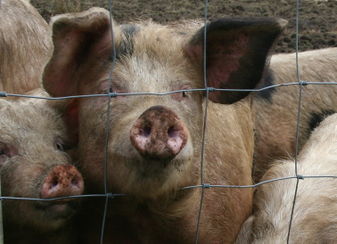Template:Sustainable eating
Contents
Impacts of Food Choices: Protein
Published: May 4, 2017
Author: Sarah Sorrell
Topic Editor: Andy Jorgensen
Topics: Food
Protein as a Nutrient
Since humans cannot biosynthesize all of the amino acids necessary to sustain life, regular ingestion of protein is an important part of the human diet [1]. Two main sources of protein in the human diet are animal-based proteins and plant-based proteins. According to the Institute of Medicine, the daily Recommended Dietary Allowance of protein for a healthy adult is 0.8 grams per kg of body weight [2]. It is important to consider the economic, environmental, and nutritive ramifications of choosing different foods as protein sources. Sustainable agriculture practices are becoming more important due to an increase in public interest of healthy and organic foods as well as development of stricter USDA standards. Shifting toward a more plant-based diet can promote sustainability, increase general health, support the welfare of livestock animals, and more effectively support the growing population [3]. That being said, the environmental and health effects of ones diet can be extremely complex and the information contained in this article is not necessarily universally true for all human diets.
Animal-Based Protein
Animal-based protein can be defined as protein-containing materials derived from the body of an animal, such as eggs, dairy, meat, fat, and other products. The amino acids contained in animal products are much more similar to those found in the human body than those found in plants, making them more readily usable. Livestock animals typically require more land and water per organism than plant crops, rendering them less economically and environmentally efficient [4]. The production and consumption of animal products have a series of environmental and human-health effects.
Environmental Effects
The industry of raising livestock for food purposes has flourished over the past century due to an increase in demand for animal products and a continuously growing population. This has caused a significant increase in the area of land needed to raise livestock, promoting deforestation and loss of natural habitats [5]. Oftentimes, livestock animals are given antibiotics and steroids along with their regular diets of grains, grass, food wastes, and even rendered animal wastes. Animal flatulence and manure are known contributors of greenhouse gas emissions [6]. Animal manure, which is sometimes used as fertilizer, is often carried away by rainwater and deposited into surrounding bodies of water, causing contamination.
Health Effects
It has been suggested that regularly eating meat can cause quite a few negative health effects in human consumers such as obesity [7], certain cancers [8][9][10], and diabetes [11]. Most of these studies have linked the development of the aforementioned diseases to excess consumption of red meat, and especially processed meats like sausage, pepperoni, and salami.
Plant-Based Protein
Plant-based protein can be defined as protein that is derived from a living organism that supports itself through photosynthesis. This includes fruits, legumes, nuts, vegetables, and whole grains like brown rice, quinoa, bulgar, and oats. While plants indeed contain the 20 amino acids, they typically contain lower levels per serving than animal products do. The aspects of production and consumption of these products have a series of environmental and human-health effects.
Environmental Effects
There are many factors one must consider for farm maintenance including land conversion, maintenance of farm equipment, and use of pesticides. In order to have room to produce large crops, farmers have cleared lands that were home to wildlife, plants, and trees to convert them into flat areas suitable for farming. This has led to deforestation and loss of natural habitats for woodland animals [12]. Farm equipment such as tractors, cultivators, and harrows provide a great deal of assistance on modern farms. Unfortunately, there are a few drawbacks that come with use of farm machinery. Many of these machines use non-renewable energy sources and have the potential of leaking fuel, oil, and other toxic fluids. Chemical pesticides such as insecticides, herbicides, and fungicides are frequently sprayed over farm crops to protect them. Though all of these chemicals provide benefits in terms of crop health and turnover, each can exhibit negative effects. Insecticides can kill non-target species such as bees, which are essential for the pollination of many crops, not including corn, wheat, and soy [13].Health Effects
Chemicals used on crops have been known to remain on produce, even to the point of human ingestion. Direct exposure to these chemicals can cause acute skin, eye, and respiratory irritation. In the long term, direct and indirect exposure has been linked to the development of asthma, cancer, leukemia, diabetes, Parkinson's disease, and may even be linked to certain cognitive impairments [14]. Cleaning produce during food preparation and choosing organic produce are just a couple ways to decrease or eliminate pesticide exposure.
Regular consumption of plant based protein has been shown to decrease risk of developing cardiovascular diseases, diabetes, and even cancer. Plant-based diets have also been shown to help maintain healthy cholesterol levels, maintain a healthy body weight and BMI, and lower blood pressure [15].
Plant-Based Diets
- Flexitarianism - a mostly plant-based diet including no-kill animal products (eggs, dairy, etc.) while consuming meat occasionally
- Vegetarianism - a plant-based diet including no-kill animal products (eggs, dairy, etc.)
- Veganism - a plant-based diet including no animal products
Further Reading
- Pilgeram, R. (2013). The Political and Economic Consequences of Defining Sustainable Agriculture in the US. Sociology Compass, 7(2), 123-134. doi:10.1111/soc4.12015
- Delmonico, S. (2016). The Protein Shift: Plant-Based Options. IDEA Fitness Journal 6-13.
References
1. Voet D, Voet JG. (2004). Biochemistry Vol 1 3rd ed. Wiley: Hoboken, NJ.
2. IOM (Institute of Medicine). 2006. Dietary Reference Intakesfor Energy, Carbohydrate, Fiber, Fat, Fatty Acids, Cholesterol, Protein and Amino Acids. Washington, D.C.: National Academies Press.
3. Graça, J., Oliveira, A., & Calheiros, M. M. (2015). Research report: Meat, beyond the plate. Data-driven hypotheses for understanding consumer willingness to adopt a more plant-based diet. Appetite, 9080-90. doi:10.1016/j.appet.2015.02.037
4. Delmonico, S. (2016). The Protein Shift: Plant-Based Options. IDEA Fitness Journal 6-13.
5. Hecht, S. (1993). The logic of livestock and deforestation in Amazonia. Bioscience, (10), 687.
6. Aguirre-Villegas, H. A., & Larson, R. A. (2017). Evaluating greenhouse gas emissions from dairy manure management practices using survey data and lifecycle tools. Journal Of Cleaner Production, 143169-179. doi:10.1016/j.jclepro.2016.12.133
7. Baillie-Hamilton, P. (n.d). Chemical toxins: A hypothesis to explain the global obesity epidemic. Journal Of Alternative And Complementary Medicine, 8(2), 185-192.
8. Kassier, S. (2016). Colon cancer and the consumption of red and processed meat: an association that is medium, rare or well done?. South African Journal Of Clinical Nutrition, 29(4), 145-149. doi:10.1080/16070658.2016.1217645
9. Lippi, G., Mattiuzzi, C., & Cervellin, G. (2016). Review: Meat consumption and cancer risk: a critical review of published meta-analyses. Critical Reviews In Oncology / Hematology, 971-14. doi:10.1016/j.critrevonc.2015.11.008
10. Mourouti, N., Kontogianni, M. D., Papavagelis, C., Plytzanopoulou, P., Vassilakou, T., Psaltopoulou, T., & ... Panagiotakos, D. B. (2015). Meat consumption and breast cancer: A case–control study in women. Meat Science, 100195-201. doi:10.1016/j.meatsci.2014.10.019
11. Feskens, E., Sluik, D., & van Woudenbergh, G. (n.d). Meat Consumption, Diabetes, and Its Complications. Current Diabetes Reports, 13(2), 298-306.
12. Silva, J. d., Prasad, S., & Diniz-Filho, J. F. (2017). The impact of deforestation, urbanization, public investments, and agriculture on human welfare in the Brazilian Amazonia. Land Use Policy, 65135-142. doi:10.1016/j.landusepol.2017.04.003
13. Matthews, G. A. (2016). Pesticides : health, safety and the environment. Chichester, England : Wiley Blackwell, 2016.
14. Kim, K., Kabir, E., & Jahan, S. A. (2017). Review: Exposure to pesticides and the associated human health effects. Science Of The Total Environment, 575525-535. doi:10.1016/j.scitotenv.2016.09.009
15. Levin, S. (2014). More Evidence on Meat's Negative Health Effects. Good Medicine, 23(2), 5.
Citation
Sorrell, S. (2017, May 4). Impacts of Food Choices: Protein. Retrieved from: http://editors.eol.org/eoearth/index.php?title=Template:Sustainable_eating

